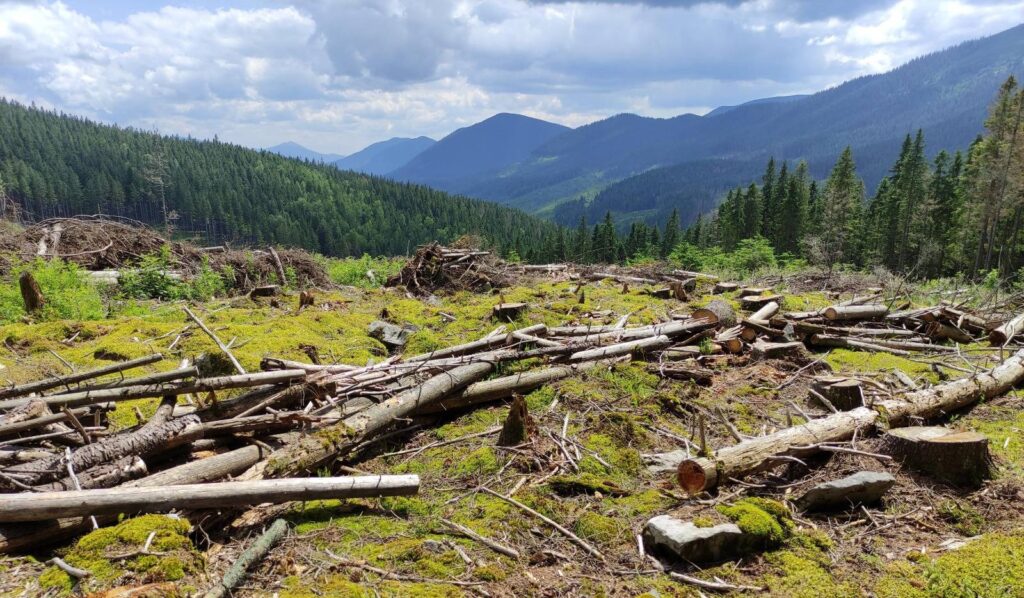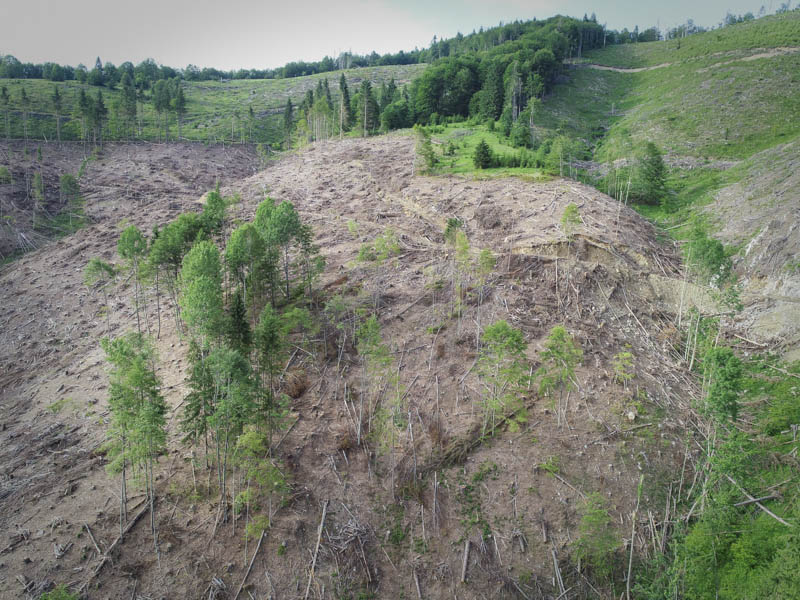In late September, the State Ecological Inspection in the Transcarpathian region received a message about massive clearance in the forest near the road to Bukovel. It was found that at least 1,500 trees were cut down there without any documents. The inspectors evaluated the damage done by the illegal loggers at UAH 32 million. It is not only about the cost of the destroyed forest — some logs were dragged by horses along mountain streams, damaging their beds and the surrounding ecosystem.
“The call came through the EcoThreat service The official service of the Ministry of Environment which can be used by anyone to report ecological threats in real-time with geo-referencing. The trees were logged in the territory of the Yasinia forestry. “I don’t claim that the forestry took part in this scheme, but it is true that they didn’t control the territory properly,” Vladyslav Kamentsa, i.o. Head of the Department of Ecological Surveillance of the State Ecological Inspection in the Transcarpathian region, said to NGL.media
In his words, the inspectors working at the scene had never seen so much ruined forest. “The only thing left of a stream was a swamp covered with a layer of sawdust. It means that [the logs] had been dragged for at least several months,” Kamentsa said.
NGL.media publishes only exclusive investigations and analytics based on big data. Please support our work so we can make more content like this
Such stories happen in the Carpathian Mountains regularly. And the scheme of the crime has not changed much in the last 100 years — the most valuable trees are cut down and dragged by horses along the riverbeds.
NGL.media analysed the satellite images from the international organization Global Land Analysis and Discovery (GLAD) and found out that in 20 recent years, about 161 thousand hectares were cut down in the Ukrainian part of the Carpathian Mountains — which is about 10% of the entire forest canopy. 80% of these losses are in the forestries of the State Forest Resources Agency. The remaining losses were incurred in the communal forests, the reserve lands, and the forests, directly subordinate to the ministries — the Ministry of Defence, the Ministry of Education, or the Ministry of Agrarian Policy.
If it is hard for you to evaluate the scale of the forest loss of 161 thousand hectares, just imagine that this is the total combined area of Kyiv, Kharkiv, Odesa, Lviv, Ivano-Frankivsk, and Ternopil!
The losses in the Carpathian Mountains, 2000–2023
To view more detailed information on forestry, use the cursor (on mobile devices, you need to “tap” on the territory). We also calculated the rate of increase for each forestry, but these data should not be compared with losses, since the increase in green areas does not always indicate the reproduction of the forest itself.
They cut down the trees which can be sold at a high price
The study by Greenpeace (pdf) shows that the Carpathian Mountains lose forests rapidly. In this mountainous system, located in the territory of eight countries Ukraine, Poland, Czech Republic, Hungary, Romania, Serbia, and Austria, four hectares of forest are cut down per hour, which makes about 20 trees per minute. Very often, these are mature and valuable species of trees that can be sold profitably.
“I remember that in the late 1990s, oak furniture became fashionable in Europe. One of the most popular and valuable products in the timber market was oak veneer sheet — a thin layer of timber (a thin board) of 0.35–4.0 mm used to cover the furniture. In those times, the Stryi forestry cut down an entire belt of oak forests situated on the hills of the Ciscarpathia and in the flood plain of the Dniester. What we have left are miserable remains of those oaks, mostly the ones located in the territory of the natural reserve fund,” Bohdan Prots, the director of the NGO Danube-Carpathian Programme, explains.
As per Prots, European research demonstrates that up to 50–70% of clearances in Ukraine are illegal. At the same time, the data of the State Forest Resources Agency show that this share does not exceed 0.3–0.6% of the total amount of the logged timber. This striking difference in estimates is related to the fact that most large-scale clearances look like legal ones, i.e., in fact, the foresters do have documents, but the way these have been obtained is quite another matter.
“We are talking about such types of clearances as sanitary clearances The removal of dry, weak, or damaged trees due to the impact of pests or diseases, reforming clearances A change of the forest structure — from monoculture and single-age plantations to mixed ones or passage clearances for better growth of trees. These are meant to happen when scientists and laws of Ukraine envisage specific types of clearances to take care of forests, i.e., they have a noble purpose, which, in reality, is achieved only on paper. In practice, the best timber is taken from the forests to obtain the highest profit,” Dmytro Karabchuk, the founder and executive director of the NGO Forest Initiatives and Society, a coordinator of the project “Combating Illegal Clearances in Ukraine”, explains.
According to the experts, the share of quality forests — especially protective and old-growth forests — decreases constantly. The consequence is that the Carpathians become more vulnerable to erosions, slides, floods, and the disappearance of local species of animals and plants.
“In fact, the horrible thing is not even the logging but the fact that the forest does not recover at that place. This process is called deforestation,” Dmytro Karabchuk explains. “For instance, the area at the mountain resort “Bukovel”, where the forest was cut down in the territory of the local forestry, and the hotels were built in its place”.
Another example of deforestation is when they cut down a large territory of the forest, which cannot recover on its own, and the planted young trees do not take root.
“There is the Mokrianskyi forestry in the Transcarpathian, where the sanitary clearances led to the condition that the forest cannot recover on one of the mountains at all. In plain terms, the climate has changed, the wind dries the earth, and when there is no precipitation, the drought is so critical that young trees merely die,” Dmytro Karabchuk explains.
According to him, not any logging should be condemned since people have always been using and will continue to use timber. “But mature trees should be cut down keeping the golden rule in mind: for the forest to have a chance to recover, not more than 1% a year should be cut down,” the expert says.
Yet, it is not that simple. For instance, the Carpathian foresters consider the beeches, aged 100–120 years, to be mature; these standards were approved as far back as the 1980s. Instead, recent research by the European Forestry Institute demonstrates that the biological maturity of beeches may come even at the age of 500 years — everything depends on the region, climate, and other conditions.
New law – new schemes
It seemed like the situation with clearances in the Carpathians could have been improved with the new version of the Law “On Banning Total Clearances in Mountainous Silver Fir-Beech Forests in the Carpathian Region”, adopted in 2019. It looked as if the moratorium was set for forest clearances, but the exception was made for sanitary clearances cutting down sick or damaged trees. Gradual clearance of mature trees was allowed as well.
“The consequence of this ban was as follows: foresters started making up that the forest was sick and sanitary clearances were required. In plain words, they find the gaps in the law to cut down the trees in the places banned by the state,” said Petro Tiestov, an ecologist and representative of the Ukrainian Nature Conservation Group.
One of the most widespread schemes has been the reforming clearances when only a small share of timber is regularly removed from the areas scheduled for logging. Petro Tiestov explains that at the height of 800-900 meters in the Carpathians, there should be beech and silver fir forests instead of artificially planted spruce trees, which dry up because of unsuitable local conditions. In 50 years of selective clearances, a spruce forest may be reformed into a beech forest without any total clearance. But it is very hard to practically check which trees have been cut down.
“In the Lviv region, we see cases where foresters announce reformatting clearances regardless of the actual presence of spruce trees. A vivid example can be found in the Zelemin landscape reserve, where the beech-silver fir forest was declared “incorrect”, and under the pretence of “reforming”, they cut down everything they wanted,” Petro Tiestov said.
Another common scheme is when the clearance is scheduled for one hectare, and 1.1 hectare is actually logged. This is a way to receive the additional 10% profit without much effort.
Will a more severe punishment resolve this situation?
One of the reasons why illegal forest clearances are so popular is the absence of severe punishment. At present, the illegal logging or illegal transportation, storage, and sale of timber is punished according to Article 246 of CCU, which envisages up to five years of imprisonment. As for employees of the forestry, they are persecuted for negligence at work (Article 367 of the CCU), which also envisages a maximum of five years. Yet actual prison sentences are quite rare.
For instance, last year, in the Transcarpathian region, Dmytro Shandra, a 54-year-old chief forester of the Irshava forestry, was sentenced for allegedly not noticing illegal forest clearance at the cost of UAH 46 million. Shandra was sentenced to two years of imprisonment but was released from this punishment with one year of probation. In August 2024, his punishment was abolished for good behaviour and regular visits to the probation centre.
Nobody has reimbursed the loss of UAH 46 million whatsoever. The prosecutor’s office has filed a corresponding suit against the forestry but didn’t manage to pay UAH 684 thousand, which is 1.5% of the court fee from the suit amount. As a result, the court refused to consider this suit.
Oleh Storchous, a lawyer specializing in similar crimes, explained that actual imprisonment for illegal logging is more of an exception than a rule. Yet he is convinced that more severe punishment would have little effect on the scale of such cases.
“The imminence of the responsibility — this is what really matters,” said Oleh Storchous. “People, cutting trees down illegally, do not think that they might face five years of prison. They are not afraid of it. They do not think about consequences at all, and they do not intend to get caught. One can make them adhere to laws only when the threat is implemented in actual specific sentences.”
He believes that for this system to start working, it is imperative to have operational coordination between forest guards and the police. Real-time practice shows that right now, the law enforcement agencies either do not pay proper attention to this category of crimes or even become a party in the schemes of illegal logging.
This material was prepared with the financial support from the European Union. The EU4IM project, funded by the European Union, is solely responsible for its content. The content of the material is the sole responsibility of NGL.media and does not necessarily reflect the views of the European Union



